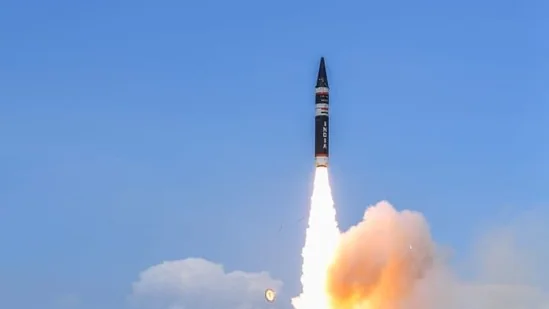Agni-P
Why in News:
- A new generation nuclear capable ballistic missile Agni-P (Prime) was successfully test-fired by the Defence Research and Development Organisation (DRDO).
- Ballistic missile is a rocket-propelled self-guided strategic-weapons system that follows a ballistic trajectory to deliver a payload from its launch site to a predetermined target. Ballistic missiles can carry conventional high explosives as well as chemical, biological, or nuclear munitions.
What makes Agni-P different?

- Agni-P is a new generation advanced variant of the Agni class of missiles. It is a canisterised missile with range capability between 1,000 and 2,000 km.
- Agni-P has improved parameters including manoeuvring and accuracy.
- Canisterisation of missiles reduces the time required to launch the missile while improving its storage and mobility.
Agni Class of Missiles
- Agni class of missiles are the mainstay of India’s nuclear launch capability which also includes the Prithvi short range ballistic missiles, submarine launched ballistic missiles and fighter aircraft. The longest of the Agni series, Agni-V, an Inter-Continental Ballistic Missile (ICBM) with a range of over 5,000 km.
- In the last few years, India has also operationalized its submarine-based nuclear launch capability, completing the nuclear triad.
- This is especially important given India’s No-First-Use policy while reserving the right of massive retaliation if struck with nuclear weapons first.
Evolution of Agni
- Agni I: Range of 700-800 km.
- Agni II: Range more than 2000 km.
- Agni III: Range of more than 2,500 Km
- Agni IV: Range is more than 3,500 km and can fire from a road mobile launcher.
- Agni-V: The longest of the Agni series, an Inter-Continental Ballistic Missile (ICBM) with a range of over 5,000 to 8000 km. An intercontinental ballistic missile (ICBM) is a missile with a minimum range of 5,500 kilometres primarily designed for nuclear weapons delivery
Related Information
IGMDP (Integrated Guided Missile Development Program)
- It was conceived by Dr. A.P.J. Abdul Kalam to enable India attain self-sufficiency in the field of missile technology.
- The 5 missiles developed under this program are:
- Agni: Ballistic missiles with different ranges, i.e. Agni (1,2,3,4,5)
- Akash: Medium range surface to air missile.
- Prithvi: Short range surface to surface ballistic missile.
- Trishul: Short range low level surface to air missile.
- Nag: 3rd generation anti-tank missile.
Canister Based Launch System
- Canister-based launch system—serves as a transporting container, a shelter to store in a ship, and gives operational flexibility.
- A canister launch system can be either hot or cold. In cold launch, the missile is expelled by gas produced by a gas generator which is not part of the missile itself, and then the missile ignites.
- Cold launch is safer than hot launch because the ejection system will automatically expel the missile if it fails. The problem with hot launches is the heat generated by the missile at the time of launch.
- The hot launch is preferable for small missiles because the ejection is handled by the missile’s own engine.
Nuclear Triad
- The nuclear triad is a three-pronged military force organisation that includes land-based nuclear missiles, nuclear-missile-armed submarines, and strategic aircraft (such as the Rafale) equipped with nuclear bombs and missiles.
- In 2020, the DRDO successfully test-fired the K-4, a submarine-launched ballistic missile with a range of 3,500 kilometres.
- These missiles will be the backbone of India’s Arihant class of indigenous ballistic missile nuclear submarines (SSBN), allowing it to launch nuclear bombs from a safe distance in Indian seas.
- The sole SSBN in operation, the INS Arihant, is presently equipped with K-15 missiles with a range of 750 kilometres.
- India has been able to complete its nuclear triad in recent years. Given India’s No-First-Use policy, which reserves the right to overwhelming retribution if attacked with nuclear weapons first, this is especially crucial.
Reference:
Subscribe
Login
0 Comments
